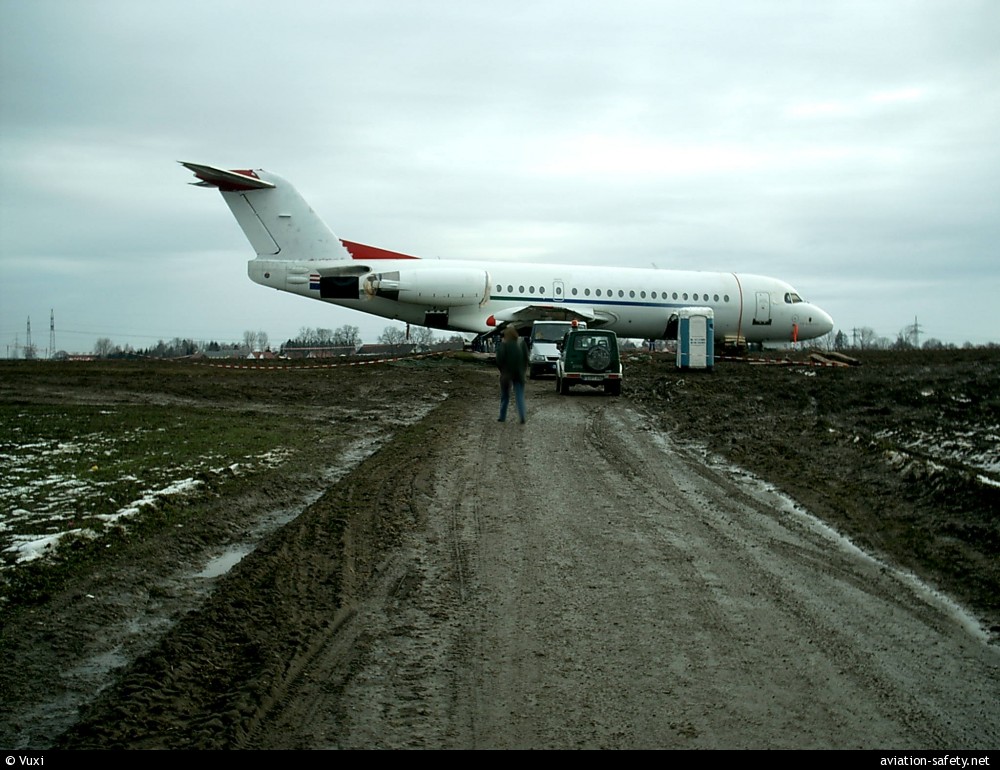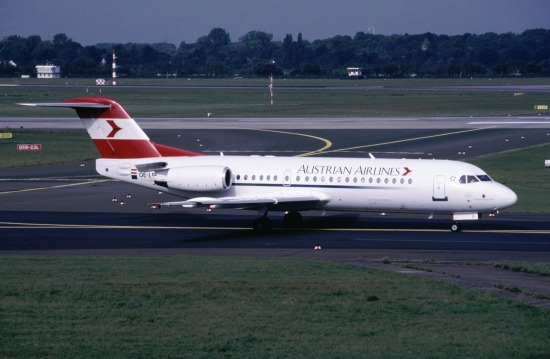
| Date: | Monday 5 January 2004 |
| Time: | 08:17 |
| Type: |  Fokker 70 |
| Owner/operator: | Austrian Airlines |
| Registration: | OE-LFO |
| MSN: | 11559 |
| Year of manufacture: | 1995 |
| Total airframe hrs: | 19304 hours |
| Cycles: | 14334 flights |
| Engine model: | Rolls-Royce Tay 620-15 |
| Fatalities: | Fatalities: 0 / Occupants: 32 |
| Aircraft damage: | Substantial, repaired |
| Category: | Accident |
| Location: | 4,5 km from München-Franz Josef Strauss Airport (MUC) -
 Germany Germany
|
| Phase: | Approach |
| Nature: | Passenger - Scheduled |
| Departure airport: | Wien-Schwechat International Airport (VIE/LOWW) |
| München-Franz Josef Strauss Airport (MUC/EDDM) | |
| Investigating agency: | BFU |
| Confidence Rating: |
Flight OS111 departed Vienna at 07:27 for a flight to Munich. A few minutes before 8 o'clock in the morning the crew were cleared to descend from FL280 to FL100. The ice detection system was triggered during descent to FL100. Engine and airframe anti-icing systems were switched on simultaneously. FL100 was reached at 07:59:58 hrs. The pilots stated that they encountered icing conditions when the airplane entered the clouds. At FL100 ice is reported to have formed at the windscreen edges. Vibrations on the no. 2 engine increased temporarily after a flight time of six minutes at FL100. As the airplane was approximately 12.5 NM south of Munich airport, the crew was instructed to descend to FL90 and to change heading to 020 degrees. Heavy vibrations on the no. 2 engine occurred during descent. According to crew statements, the airbrakes were extended in order to increase thrust setting on the engines without increase in airspeed. Immediately afterwards the warning VIB HIGH ENG2 was triggered at FL90. The actions of the Abnormal Procedure Vibration High checklist were carried out. However, the no. 2 engine was not shut down for lack of other failure indications. Afterwards no more problems for the no. 2 engine were indicated. Simultaneously with the strong vibrations, vibrations and noises from the rear cabin area were heard in the cockpit. At 08:08:14 hrs the EPR of the no. 1 engine dropped from 1.5 to 1.1 and stayed at about 1.0 after that. In the cockpit heavy vibrations had been noticed also and a rattling noise had been heard. But the vibrations were not displayed on the multifunctional display as originating from the engines. At 08:08:22 hrs, the captain declared an emergency because of severe engine problems and requested an immediate landing. The airplane was immediately cleared to descend to 5,000 ft based on a QNH of 1,017 hPa and to change to a heading of 080 degrees. The crew requested an approach as short as possible. While leaving FL90, the EPR of the no. 1 engine dropped also from 1.4 to 1.0 within the next four minutes; this EPR reduction was incremental and occurred independent of the thrust setting. At 7,000 ft the air brakes were extended for a short time and engine thrust increased. During the descent to 5,000 ft the airplane was transferred to Munich Director. After 08:12:45 hrs when the airplane had reached approximately 5,000 ft the EPR of the no. 2 engine retained values of about 1.0 also. Munich Director immediately issued a clearance to further descend to 3,500 ft. The air brakes where extended again for a period of 44 seconds. Thereby the airspeed was reduced to approximately 170 kt. With the landing gears extended and the flaps set to 15 degrees, the airspeed was about 150 kt. The airplane was guided to the landing course of the ILS 26L approximately 8 NM in front of the threshold. At approximately 4,000 ft flaps were extended to 25 degrees. After the airplane had descended in landing configuration to the cleared altitude of 3,500 ft and horizontal flight had been established, the crew noticed that by pushing the thrust levers forward, the EPR on both engines did not increase to the required value. The speeds N1 and N2 and the exhaust gas temperatures (EGT) of both engines increased, the EPRs, however, remained at values of around 1.0. After the message of the crew that they were just approaching the ILS the flight was transferred to Munich Tower. Airspeed decreased to approximately 115 kt. The autopilot was immediately switched off, the airplane again established in descent, the flaps reset to 15 degrees and the landing gears retracted. Airspeed increased to approximately 135 kt. The flaps were again set to 25 degrees. The airplane received clearance to land. At 08:16:10 hrs the controller informed the crew that the Fokker was approximately 500 ft below the glide path. At this time the height measured by the radio altimeter was 500 ft AGL. At the same time the GPWS sounded: "Too low" and "Gear". The crew informed the controller that the runway could not be reached and that the landing would take place approximately 4 NM short of the runway: "...We will not make it...to the runway...we are touching down probable 4 Miles before the field..."). From approximately 400 ft AGL downwards the airplane was clear of clouds. The landing gear was selected down 13 seconds prior to ground contact. The captain informed the cabin crew of the imminent emergency landing through the repeated exclamation "Brace for impact" 5 seconds prior to touch down. At 08:16:35 hrs, the airplane touched down on a snow covered field approximately 2.5 NM short of the runway with landing gears partly extended and came to rest severely damaged lying on the fuselage after a sliding distance of 220 m. All occupants left the airplane without assistance via the forward passenger door exit.
The accident was due to the following immediate causes:
- After a prolonged time under moderate icing conditions and low engine thrust, ice developed on the rotors of the low pressure compressors of both engines.
- The bonded joints of the ice impact panels on both engines failed due to strains caused by ice-induced vibrations of the engines and by ice which had shedded from the rotors of the low pressure compressor.
- The loose ice impact panels became trapped in front of the outlet guide vanes of the low pressure compressor and affected the airflow in the by-pass duct in such a way that the engines now only produced low thrust.
- The runway was no longer within reach of the aircraft as the loss of thrust on both engines had not triggered any warnings and was not indicated until the necessary demand of thrust at an altitude of 3,500 ft.
- Due to its nature the terrain within reach was not suited for the landing of a transport airplane.
Accident investigation:
 |
|
Sources:
SKYbrary
Austrian Airlines
BFU
History of this aircraft
Other occurrences involving this aircraft
| 26 March 2024 | 5Y-MMB | unknown | 0 | Nairobi-Wilson Airport (WIL/HKNW) |  |
non |
| Taxiway excursion | ||||||
Images:

photo (c) Vuxi; near München; January 2004; (CC:by-sa)

photo (c) Werner Fischdick; Düsseldorf Airport (DUS); 28 September 2002
Revision history:
| Date/time | Contributor | Updates |
|---|
The Aviation Safety Network is an exclusive service provided by:


 ©2024 Flight Safety Foundation
©2024 Flight Safety Foundation